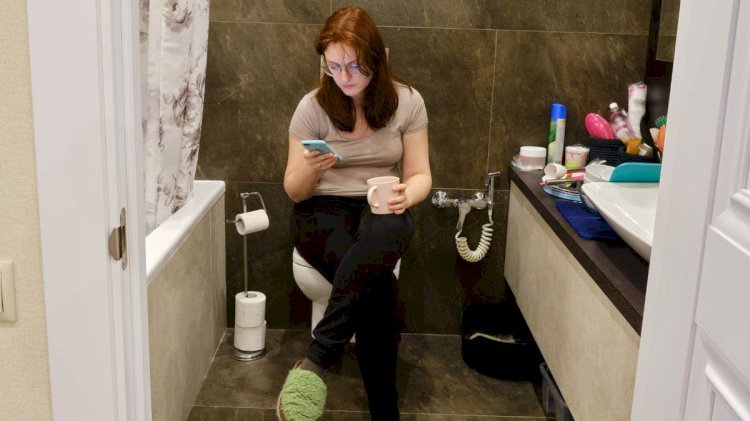The Dirty Truth About Scrolling on the Toilet — Why It’s a Global Health Epidemic (2025 Study)
New 2025 study reveals scrolling on the toilet raises hemorrhoid risk by 46%. Learn why it’s a global epidemic, health dangers, and tips to break the habit.

It’s a scenario most people won’t admit to—but nearly everyone does: taking your phone to the toilet. What once involved flipping through a newspaper or magazine has now evolved into endless doomscrolling on TikTok, Instagram, or news apps. While it might feel like a harmless way to pass a few minutes, new research published in PLOS One (Sept 2025) has revealed something far more serious: scrolling on the toilet increases the risk of hemorrhoids by 46 %.
From the U.S. to India, the U.K. to Asia, this quirky but universal habit is quickly becoming recognized as a global health issue.
How Widespread Is Toilet Scrolling?

Image source: pinterest.com
The Harvard-affiliated study examined 125 adults undergoing colonoscopies at Beth Israel Deaconess Medical Center. The findings were eye-opening:
-
66 % admitted to using their phones on the toilet.
-
93 % of these people scrolled at least once or twice a week.
-
Over half (55.4 %) confessed to using their phones nearly every bathroom trip.
-
Smartphone users tended to be younger—average age 55.4 years vs. 62.1 years among non-users.
These numbers confirm what most of us suspected: scrolling on the toilet is now a global behavioral norm, not an exception.
Why Phones Keep Us Trapped on the Toilet

Image source: pinterest.com
Unlike magazines or books, which have a natural end point, social media and news feeds are endless by design. Algorithms continuously refresh with new videos and posts, creating a feedback loop that keeps users scrolling far longer than intended.
In fact:
-
37.3 % of smartphone users sat on the toilet for over 5 minutes, compared to just 7.1 % of non-users.
-
35 % admitted they stayed longer specifically because of their phones.
This prolonged sitting is where the real danger lies.
The 46 % Hemorrhoid Risk Explained

Image source: pinterest.com
Traditionally, doctors believed straining during bowel movements was the top cause of hemorrhoids. Surprisingly, this study found no link between straining and hemorrhoid development. Instead, it’s the time spent sitting that’s to blame.
Extended sitting on a standard toilet puts direct pressure on rectal veins, causing them to swell. Over time, this leads to painful hemorrhoids—one of the most common gastrointestinal issues worldwide.
Key stats:
-
Hemorrhoids affect 50 % of adults globally by age 50.
-
In the U.S. alone, they cause 4 million medical visits annually and cost $800+ million in healthcare.
-
With smartphones driving longer bathroom stays, these numbers may only rise.
A Truly Global Epidemic

Image source: pinterest.com
This isn’t just a U.S. or Western issue—it’s happening everywhere.
-
United States: The Washington Post and Axios highlight toilet scrolling as a hidden epidemic, affecting millions and driving up healthcare costs.
-
United Kingdom: The Guardian warned of a “two TikTok limit,” urging people to keep loo time short. The Times reported that toilet scrolling increases hemorrhoid risk more than straining.
-
India: Doctors at CMC Vellore cautioned the public after the study confirmed a 46 % higher hemorrhoid risk among smartphone users. Major outlets like Times of India and Economic Times ran features.
-
Global context: The World Bank once noted that mobile phone adoption outpaced toilet access worldwide—a reminder of how deeply integrated smartphones are into daily life.
In short: toilet scrolling is universal, cutting across cultures, countries, and age groups.
More Than Just Hemorrhoids—Other Risks

Image source: pinterest.com
While hemorrhoids are the headline risk, scrolling on the toilet carries several other hidden dangers:
-
Hygiene concerns: Studies show that smartphones can carry more bacteria than toilet seats, increasing the risk of cross-contamination.
-
Pelvic health issues: Prolonged sitting without proper support strains pelvic muscles and can contribute to long-term discomfort.
-
Posture problems: Leaning forward while scrolling places stress on the lower back and spine.
-
Mental health impact: Bathroom scrolling is another form of compulsive phone use, feeding into smartphone addiction and digital dependence. This doesn’t just affect your body—it can also drain your focus, mood, and emotional balance. For more on boosting your mental health, check out our guide on Improving Emotional Well-Being.
Together, these risks show that toilet scrolling isn’t just a quirky habit—it’s a global lifestyle issue with physical, mental, and emotional consequences.
How to Break the Habit: Expert Advice

Image source: pinterest.com
Doctors and health experts recommend practical steps to curb this global epidemic:
-
Leave your phone outside the bathroom. The easiest and most effective solution.
-
Limit toilet time to 5 minutes. Gastroenterologists emphasize: “If it hasn’t happened in five minutes, it probably won’t.”
-
Adopt healthier lifestyle habits. A high-fiber diet, regular hydration, and exercise reduce constipation, meaning less time on the toilet.
-
Improve posture. Use a foot stool or squatty posture to ease bowel movements naturally.
-
Digital hygiene. Consider setting app timers or bathroom-specific phone rules.
Some doctors even recommend the “two TikTok rule”—a playful but effective reminder that bathroom breaks shouldn’t last longer than two quick videos.
A Simple Fix to a Hidden Epidemic

Image source: pinterest.com
Scrolling on the toilet may feel like a private, harmless quirk. But with hard science now linking it to a 46 % increased hemorrhoid risk, it’s far more serious than we thought. This isn’t just a cultural trend—it’s a global health challenge tied to our growing digital dependence.
The fix, though, is simple: make your bathroom a phone-free zone. By reclaiming those minutes, you’re not just saving time—you’re protecting your health.
Conclusion
The dirty truth is out: scrolling on the toilet isn’t just awkward to admit—it’s a global epidemic with measurable health consequences. From the U.S. to India, the U.K. to Asia, the message is clear: keep your toilet trips short, distraction-free, and phone-free.
Because sometimes the best health advice is the simplest: Flush, wash, and leave—no scrolling required.
FAQs on Scrolling on the Toilet
1. Why is scrolling on the toilet bad for health?
It prolongs sitting time, which increases pressure on rectal veins and raises hemorrhoid risk.
2. Does using a phone on the toilet really cause hemorrhoids?
Yes, a PLOS One 2025 study found a 46 % higher risk among smartphone users.
3. How long is it safe to sit on the toilet?
Doctors recommend keeping bathroom visits under 5 minutes.
4. Is straining or scrolling worse for hemorrhoids?
Recent research shows sitting longer from scrolling is riskier than straining.
5. Can toilet scrolling spread germs?
Yes, phones can carry more bacteria than toilet seats, raising hygiene concerns.
6. Who is most likely to scroll on the toilet?
Younger adults are significantly more likely to use smartphones in bathrooms.
7. How can I stop scrolling on the toilet?
Leave your phone outside, set time limits, and practice healthier bathroom habits.




























